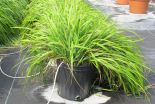(Press-News.org) BOSTON, Aug. 17, 2015 --Native North Americans have long adorned themselves and their homes with fragrant sweetgrass (Hierochloe odorata), a native plant used in traditional medicine, to repel biting insects, and mosquitoes in particular. Now, researchers report that they have identified the compounds in sweetgrass that keep these bugs at bay.
The team will describe their approach in one of more than 9,000 presentations at the 250th National Meeting & Exposition of the American Chemical Society (ACS), the world's largest scientific society, taking place here through Thursday.
Mosquitoes and other insects remain a pesky part of everyday life in many parts of the world, and their bites are linked to a range of serious diseases, such as malaria. To add to the arsenal of insect repellents, Charles Cantrell, Ph.D., investigates the components of plants used in traditional therapies. "We found that in our search for new insect repellents, folk remedies have provided good leads."
Sweetgrass is a meadow grass that is a native to northern climates, Cantrell says. "It gives off a sweet aroma that repels mosquitoes."
He therefore suspected that the active insect-repelling chemicals must waft off sweetgrass at ambient temperatures and, like essential oils from lavender and other plants, could be extracted using a process known as steam distillation. This method involves passing hot steam through plant material, then lowering the temperature. The condensed liquid then separates into oil and water, with the oil fraction containing the volatile chemicals of interest. So, Cantrell's team at the U.S. Department of Agriculture, in collaboration with researchers at the University of Guelph and the University of Mississippi, performed steam distillation on sweetgrass samples and evaluated its oil for the ability to deter mosquitoes from biting.
To test the mosquitoes' aversion to the oil, the researchers filled small vials with a red-colored feeding solution that mimicked human blood and covered the vials with a thin membrane. Then, they coated the membranes with different substances: the sweetgrass oil, alternative sweetgrass extracts obtained without steam distillation, the gold-standard insect repellent N,N-diethyl-m-toluamide (DEET) or the ethanol solvent control. Then, the bugs got the chance to either bite the membranes to get to the blood or pass them by. The researchers observed what the insects did, counting how many mosquitoes went for a bite of each type of "blood" vat.
"Then you take the mosquitoes and squish them on some paper," says Cantrell. "If they have the blood mimic in them, you see it right there on the paper." Of the sweetgrass extracts, the steam-distilled oil got the fewest mosquito bites, matching the repellent potency of DEET.
The next step was to figure out the exact chemicals that give the sweetgrass oil its anti-mosquito power. The researchers purified the oil into 12 fractions and again checked their ability to ward off the bugs. They found three fractions that repelled mosquitoes as well as the oil. Using nuclear magnetic resonance (NMR) spectroscopy and mass spectrometry, the researchers identified two chemicals in these active fractions that seemed to be responsible for putting off mosquitoes: phytol and coumarin.
Coumarin is an ingredient in some commercial anti-mosquito products, he adds, while phytol is reported to have repelling activity in the scientific literature. So although Cantrell didn't find brand-new insect deterrents in this experiment, he is happy to have demonstrated that "we were able to find constituents that are known to act as insect repellents in a folk remedy, and now we understand that there's a real scientific basis to this folklore."
INFORMATION:
A press conference on this topic will be held Tuesday, Aug. 18, at 10:30 a.m. Eastern time in the Boston Convention & Exhibition Center. Reporters may check-in at Room 153B in person, or watch live on YouTube http://bit.ly/ACSLiveBoston. To ask questions online, sign in with a Google account.
Cantrell acknowledges that the study was supported in part by a Deployed War-Fighter Protection research program grant funded by the U.S. Department of Defense through the Armed Forces Pest Management Board.
The American Chemical Society is a nonprofit organization chartered by the U.S. Congress. With more than 158,000 members, ACS is the world's largest scientific society and a global leader in providing access to chemistry-related research through its multiple databases, peer-reviewed journals and scientific conferences. Its main offices are in Washington, D.C., and Columbus, Ohio.
To automatically receive news releases from the American Chemical Society, contact newsroom@acs.org.
Note to journalists: Please report that this research is being presented at a meeting of the American Chemical Society.
Follow us: Twitter | Facebook
Title
Isolation and Identification of Potential Biopesticidal Compounds from the North American Insect Repelling Folk Remedy Plant, Sweetgrass, Hierochloe odorata (L.) P. Beauv.
Abstract
Native North Americans used sweetgrass, Hierochloe odorata, in a variety of ceremonies and rituals. It has also been used to repel biting insects by making a loop from strands of the grass to be worn around the neck or kept in a satchel hung in homes. This investigation was conducted to evaluate this practice and systematically identify chemical constituents responsible for the mosquito repelling effect by utilizing a mosquito (Aedes aegypti) biting deterrent bioactivity-directed purification approach. Fresh steam distilled oil was found to be the most active crude extract generated from sweetgrass and was used in fractionation studies providing 12 distinct fractions. Fractions identified as having activity equivalent to N,N-diethyl-m-toluamide (DEET) contained the compounds phytol and coumarin. Ae. aegypti biting deterrent results will be reported for the active fraction and pure compounds.
BOSTON, Aug. 17, 2015 -- Hand-written letters and printed photos seem quaint in today's digital age. But there's one thing that traditional media have over hard drives: longevity. To address this modern shortcoming, scientists are turning to DNA to save unprecedented amounts of digital data for posterity. One team has demonstrated that DNA they encapsulated can preserve information for at least 2,000 years, and they're now working on a filing system to make it easier to navigate.
The researchers present their work today at the 250th National Meeting & Exposition of the ...
BOSTON, Aug. 17, 2015 -- A blood clot is a dangerous health situation with the potential to trigger heart attacks, strokes and other medical emergencies. To treat a blood clot, doctors need to find its exact location. But current clinical techniques can only look at one part of the body at a time, slowing treatment and increasing the risk for complications. Now, researchers are reporting a method, tested in rats, that may someday allow health care providers to quickly scan the entire body for a blood clot.
The team will describe their approach in one of more than 9,000 ...
BOSTON, Aug.17, 2015 -- In a first-of-its-kind study, researchers have determined that natural sunlight triggers the release of smog-forming nitrogen oxide compounds from the grime that typically coats buildings, statues and other outdoor surfaces in urban areas. The finding confirms previous laboratory work using simulated sunlight and upends the long-held notion that nitrates in urban grime are "locked" in place.
The scientists will present their findings based on field studies conducted in Leipzig, Germany, and Toronto, Canada, at the 250th National Meeting & Exposition ...
New Internet-based technology may aid criminal justice agencies through tools such as better criminal databases, remotely conducted criminal trials and electronic monitoring of parolees in the community, according to a new RAND Corporation study.
Top criminal justice priorities for new Internet tools include developing a common criminal history record that can be shared across agencies, developing real-time language translation tools and improved video displays for law enforcement officers to adapt to changing needs, according to the analysis.
"The criminal justice ...
During the deer's breeding season, or rut, the researchers from Queen Mary University of London (QMUL) and ETH Zürich, played male fallow deer (bucks) in Petworth Park in West Sussex, a variety of different calls that had been digitally manipulated to change the pitch and length and analysed their responses. The bucks treated lower pitched and longer calls as more threatening, by looking towards source of the call sooner and for longer, than others.
Fallow bucks attracted the attention of the researchers because of their intriguing calling behaviour. Males are silent ...
BOSTON, Aug. 16, 2015 -- Sunlight can be brutal. It wears down even the strongest structures, including rooftops and naval ships, and it heats up metal slides and bleachers until they're too hot to use. To fend off damage and heat from the sun's harsh rays, scientists have developed a new, environmentally friendly paint out of glass that bounces sunlight off metal surfaces -- keeping them cool and durable.
The researchers present their work today at the 250th National Meeting & Exposition of the American Chemical Society (ACS). ACS, the world's largest scientific ...
Findings from Nationwide Children's Hospital physicians demonstrate that headaches increase in fall in children, a trend that may be due to back-to-school changes in stress, routines and sleep. Although it may be difficult for parents to decipher a real headache from a child just wanting to hold onto summer a little longer and avoid going back to school, there is a variety of other common triggers including poor hydration and prolonged screen time that could contribute to a child's discomfort.
"When we saw many of our families and patients in clinic, the families would ...
BUFFALO, N.Y. - Medicare Part D provides help to beneficiaries struggling with the cost of prescriptions drugs, but the plan's coverage gap hits some populations harder than others, particularly African-Americans age 65 and older. Reaching, or even approaching, the gap affects access to medication and influences whether those medications are taken as prescribed.
"Don't assume that the existence of Part D means that people aren't having a difficult time affording their meds," says Louanne Bakk, an assistant professor in the University at Buffalo School of Social Work. "There ...
SALT LAKE CITY, Aug. 14, 2015 - Software may appear to operate without bias because it strictly uses computer code to reach conclusions. That's why many companies use algorithms to help weed out job applicants when hiring for a new position.
But a team of computer scientists from the University of Utah, University of Arizona and Haverford College in Pennsylvania have discovered a way to find out if an algorithm used for hiring decisions, loan approvals and comparably weighty tasks could be biased like a human being.
The researchers, led by Suresh Venkatasubramanian, ...
Discovered in 1982, Helicobacter pylori (H. pylori) is a disease-causing bacterium that survives in our stomachs despite the harsh acidic conditions. It is estimated that one in two people have got it, though most won't ever experience any problems. Even so, it is considered one of the most common bacterial infections worldwide and a leading cause of dyspepsia, peptic ulceration and gastric cancer.
Through unique evolutionary adaptations, H. pylori is able to evade the antiseptic effect of our stomach acid by hiding within the thick acid-resistant layer of mucus that ...




